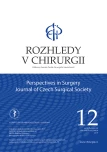Treatment of liver injuries at the Trauma Centre of the University Hospital in Pilsen
Authors:
O. Vyčítal 1,2; O. Horský 1,2; J. Rosendorf 1,2; V. Liška 1,2; T. Skalický 1; V. Třeška 1
Authors place of work:
Chirurgická klinika Lékařské fakulty v Plzni Univerzity Karlovy a Fakultní nemocnice Plzeň
1; Biomedicínské centrum, Lékařská fakulta v Plzni Univerzity Karlovy
2
Published in the journal:
Rozhl. Chir., 2019, roč. 98, č. 12, s. 488-491.
Category:
Původní práce
doi:
https://doi.org/10.33699/PIS.2019.98.12.488–491
Summary
Introduction: Traumatic liver injury is the most frequent cause of death due to traumatic bleeding in the peritoneal cavity. The progress of pre-hospital emergency medical service, improved surgical techniques, and advanced post-operative care decreased the morbidity from 65% to 10% over the last 40 years. The management is either surgical or non-surgical. Operation is indicated in case of haemodynamic instability and failure of non-surgical treatment. The aim of the paper is to evaluate the aetiology of liver injury, the type of treatment, and therapeutic results in patients hospitalized between 2006 and 2018 at the Trauma Centre of the University Hospital in Pilsen.
Methods: Our retrospective study includes 322 patients. Assessed characteristics: Type of injury (polytraumatic or monotraumatic), cause of trauma, trauma grade according to The American Association for the Surgery of Trauma, type of treatment, complications, mortality and the length of stay.
Results: There were 191 male and 131 female patients included in the study; 18.9% of these were children below the age of 16. Polytraumata represented 53.1%, multiple traumata 35.4% and monotraumata 11.5% of all injuries; 94.7% of patients had a blunt trauma of the liver and the most common reason of injury was traffic accident (57.8%). Conservative management was applied in 66.1% of all patients. The following surgical procedures were performed: liver packing (34 cases), exploration and drainage (10), liver resection (5), laparoscopy (7), radiofrequency ablation (3), cholecystectomy (2), and one case of bile duct revision. Thirty-day mortality was 7.7%. One patient died of bilateral pneumonia; the other non-surviving patients died of decompensated hemorrhagic shock or due to craniocerebral injury.
Conclusion: Complex and centralized medical care of patients with liver trauma not only allows appropriate primary therapy, but it is also a precondition for the management of further specific complications.
Keywords:
visceral surgery – traumatology – liver injury
Zdroje
- Skalický T. Chirurgie jater. Maxdorf Jessenius 2004.
- Třeška V, Skalický T, Šimánek V, et al. Diagnostika a léčba poranění jater. Rozhl Chir. 2006;85:159–62.
- Richards JR, McGahan JP. Radiology. Focused assessment with sonography in trauma (FAST) in 2017: What radiologists can learn. 2017;283:30–48. doi: 10.1148/radiol.2017160107.
- LeBedis CA, Bates DDB, Soto JA. Iatrogenic, blunt, and penetrating trauma to the biliary tract. Abdom Radiol. (NY). 2017;42:28–45. doi: 10.1007/s00261-016-0856-y.
- Vyhnánek F, Denemark L, Ducháč V. Obecné diagnostické a terapeutické postupy u poranění jater. Acta Chir Orthop Traumatol Czech. 2003;70:219–25.
- Injury Scoring Scale: A resource for trauma care professionals.The American Association for the Surgery of Trauma. Chicago 2019. [online]. Available from: http://www.aast.org/Library/TraumaTools/InjuryScoringScales.aspx#htmlBody
- Kozar RA, Feliciano DV, Moore EE, et al. Western trauma association/critical decisions in trauma: operative management of adult blunt hepatic trauma. J Trauma 2011;71:1–5.doi: 10.1097/TA.0b013e318220b192.
- Štefka J, Vyhnánek F. Postup u poranění jater v traumatologickém centru FN Královské Vinohrady. Úraz chir. 2015;23:90–4.
- Sharrock AE, Midwinter M. Damage control - trauma care in the first hour and beyond: a clinical review of relevant developments in the field of trauma care. Ann R Coll Surg Engl. 2013;95:177–83. doi: 10.1308/003588413X13511609958253.
- Dindo DN, Demartines N, Clavien PA. Classification of surgical complications: a new proposal with evaluation in a cohort of 6336 patients and results of a survey. Ann Surg. 2004;240:205–13. doi: 10.1097/01.sla.0000133083.54934.ae.
- Skalický T, Třeška V, Šnajdauf J. Hepato-pankreato-biliární chirurgie. Praha, Maxdorf Jessenius 2011.
- Vyhnánek F. Současný postup u poranění jater. Úraz chir. 2012;20:1–7.
- Schroeppel TJ, Croce MA. Diagnosis and management of blunt abdominal solid organ injury. Curr Opin Crit Care. 2007;13:399–404. doi: 10.1097/MCC.0b013e32825a6a32.
- Gaski IA, Skattum J, Brooks A. Decreased mortality, laparotomy, and embolization rates for liver injuries during a 13-year period in a major Scandinavian traumacenter. Trauma Surg Acute Care Open. 2018;3:e000205. doi: 10.1136/tsaco-2018-000205.
Štítky
Chirurgie všeobecná Ortopedie Urgentní medicínaČlánek vyšel v časopise
Rozhledy v chirurgii

2019 Číslo 12
- Metamizol jako analgetikum první volby: kdy, pro koho, jak a proč?
- MUDr. Lenka Klimešová: Multioborová vizita může být klíčem k efektivnější perioperační léčbě chronické bolesti
- Primární prevence osteoporózy v kostce
Nejčtenější v tomto čísle
- Načasování cholecystektomie v terapii akutní kalkulózní cholecystitidy
- Přednemocniční aplikace transfuzních přípravků a krevních derivátů
- Léčba poranění jater v traumacentru Fakultní nemocnice Plzeň
- Cholangioskopie a intraduktální sonografie v diagnostice karcinomu žlučových cest
